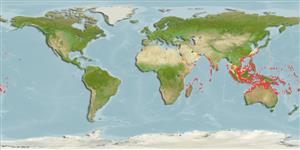Actinopterygii (ray-finned fishes) >
Perciformes (Perch-likes) >
Serranidae (Sea basses: groupers and fairy basslets) > Epinephelinae
Etymology: Anyperodon: Greek, ana = up + Greek, yper = on the top + Greek, odous = teeth (Ref. 45335).
Environment / Climate / Range
Ecology
Marine; reef-associated; non-migratory; depth range 5 - 80 m (Ref. 89707), usually 5 - 50 m (Ref. 37816). Tropical, preferred ?; 32°N - 24°S, 32°E - 171°W (Ref. 5222)
Indo-Pacific: Red Sea south to Mozambique and east to the Phoenix Islands, north to Japan, south to Australia. Probably including all the islands of the tropical Indian Ocean.
Length at first maturity / Size / Weight / Age
Maturity: Lm ?, range 30 - ? cm
Max length : 65.0 cm TL male/unsexed; (Ref. 11441)
Dorsal
spines
(total): 11;
Dorsal
soft rays
(total): 14-16;
Anal
spines: 3;
Anal
soft rays: 8 - 9. Juveniles with alternating blue and red stripes and 1or 2 black spots at caudal base (Ref. 4319); adults with greenish to brownish grey color with reddish spots overall; 3-4 pale stripes on side of variable intensity; body elongate, greatest depth 3.1-3.7 in SL; rounded caudal fin; short pelvic fins, not reaching anus (Ref. 90102); head pointed, 2.3-2.5 times in SL; interorbital region narrow, dorsal head profile almost straight; preorbital narrow, depth 14-17 times in HL; snout distinctly longer than eye; rounded preopercle, finely serrate, lower serrae only slightly enlarged, lower edge fleshy; ventral edge of interopercle with a shallow indentation: opercular spines small, upper edge of operculum distinctly convex; maxilla reaches past eye, exposed part covered with tiny cycloid scales; rear end of maxilla without bony process; well developed supramaxilla; palatines without teeth; canines at front of jaws rudimentary or absent (Ref. 89707).
Inhabits coral rich areas and clear waters on lagoon and seaward reefs. Feeds mainly on fishes and probably on crustaceans. The distinctive blue and gold striped juveniles are mimics of the wrasse Halichoeres purpurescens. Juveniles mimic some of the small lined wrasses of the genus Halichoeres or dark damsels in surge zones (Ref. 48635). This allows the species to approach their preys. In Hong Kong live fish markets (Ref. 27253). Solitary (Ref 90102).
Life cycle and mating behavior
Maturity | Reproduction | Spawning | Eggs | Fecundity | Larvae
Heemstra, P.C. and J.E. Randall, 1993. FAO Species Catalogue. Vol. 16. Groupers of the world (family Serranidae, subfamily Epinephelinae). An annotated and illustrated catalogue of the grouper, rockcod, hind, coral grouper and lyretail species known to date. Rome: FAO. FAO Fish. Synop. 125(16):382 p. (Ref. 5222)
IUCN Red List Status (Ref. 115185)
CITES (Ref. 94142)
Not Evaluated
Threat to humans
Harmless
Human uses
Fisheries: minor commercial; gamefish: yes
More information
ReferencesAquacultureAquaculture profileStrainsGeneticsAllele frequenciesHeritabilityDiseasesProcessingMass conversion
Tools
Special reports
Download XML
Internet sources
